#macos is better than windows
Explore tagged Tumblr posts
Note
favorite Linux specific feature?
ability to do dumb shit. wanna recompile the kernel with custom flags? how about with a compiler it was never meant to work with? or use a file system from a different os? or coreutils from a different os? wanna fuckin run your desktop in text only mode with a multiplexer? how about use a desktop environment from the 90s? or install a modern OS to 90s hardware? well you can. it’ll probably break shit but that’s what makes it fun :3
#but for normal people my answer is better privacy than windows with better game compatibility than macOS#idfk what to actually tag this as#linux#196 campfire
19 notes
·
View notes
Text
i become genuinely violent when people shit on macOS. the only people allowed to do that are linux users or people who use outdated windows versions. if you use fucking Windows 10 or 11 and you think current macOS users are worse off than you? grow up.
#i’m autistic about operating systems#microsoft windows#macos#linux#mac user#i am a mac user#because it’s fucking Better than newer windows
3 notes
·
View notes
Text
I don't think people realize how absolutely wild Linux is.
Here we have an Operating system that now has 100 different varieties, all of them with their own little features and markets that are also so customizable that you can literally choose what desktop environment you want. Alongside that it is the OS of choice for Supercomputers, most Web servers, and even tiny little toy computers that hackers and gadget makers use. It is the Operating System running on most of the world's smartphones. That's right. Android is a version of Linux.
It can run on literally anything up to and including a potato, and as of now desktop Linux Distros like Ubuntu and Mint are so easily to use and user friendly that technological novices can use them. This Operating system has had App stores since the 90s.
Oh, and what's more, this operating system was fuckin' built by volunteers and users alongside businesses and universities because they needed an all purpose operating system so they built one themselves and released it for free. If you know how to, you can add to this.
Oh, and it's founder wasn't some corporate hotshot. It's an introverted Swedish-speaking Finn who, while he was a student, started making his own Operating system after playing around with someone else's OS. He was going to call it Freax but the guy he got server space from named the folder of his project "Linux" (Linus Unix) and the name stuck. He operates this project from his Home office which is painted in a colour used in asylums. Man's so fucking introverted he developed the world's biggest code repo, Git, so he didn't have to deal with drama and email.
Steam adopted it meaning a LOT of games now natively run in Linux and what cannot be run natively can be adapted to run. It's now the OS used on their consoles (Steam Deck) and to this, a lot of people have found games run better on Linux than on Windows. More computers run Steam on Linux than MacOS.
On top of that the Arctic World Archive (basically the Svalbard Seed bank, but for Data) have this OS saved in their databanks so if the world ends the survivors are going to be using it.
On top of this? It's Free! No "Freemium" bullshit, no "pay to unlock" shit, no licenses, no tracking or data harvesting. If you have an old laptop that still works and a 16GB USB drive, you can go get it and install it and have a functioning computer because it uses less fucking resources than Windows. Got a shit PC? Linux Mint XFCE or Xubuntu is lightweight af. This shit is stopping eWaste.
What's more, it doesn't even scrimp on style. KDE, XFCE, Gnome, Cinnamon, all look pretty and are functional and there's even a load of people who try make their installs look pretty AF as a hobby called "ricing" with a subreddit (/r/unixporn) dedicated to it.
Linux is fucking wild.
9K notes
·
View notes
Text

COLORING + SHARPENING TUTORIAL
someone asked for a coloring tutorial and my sharpening settings, so here it is! there are also a few tips to achieve more HQ gifs. :)
tutorial under the cut!
FOR HIGH-QUALITY GIFS
FILE SIZES
it doesn’t matter what your sharpening settings are if the file you’re using to gif is too low quality, so i tend to look for the best that i can get when downloading stuff.
usually, movies (+2h) look better if they’re 5GB or more, while an episode (40 min/1h) can look good with even 1GB. the minimum definition i try to find is 1080p, but i gif with 2160p (4k) when available. unfortunately, not every computer can handle 4k, but don’t worry, you can gif with 1080p files just fine if they are big enough. contrary to popular belief, size does matter! which means sometimes a bigger 1080p file is better than a smaller 2160p one, for example.
SCREENCAPPING METHOD
this can too influence the quality of your gifs. as a gifmaker, i’ve tried it all: video frames to layers, directly opening video clips, loading files into stack, and i’ve finally settled down with opening screencaps as an image sequence. with bigger files, it doesn’t matter much what technique you use, but i’ve noticed with smaller files you can do wonders if you screencap (either by loading files into stack or opening as an image sequence) instead of using video clips. for example, this gif’s original video file was only 4GB (so smaller than i’ve usually go for), if you can believe it!

here’s a tutorial for setting up and screencapping with MPV, the media player i use to screencap. again, you can keep using video clips for bigger files, but you’ll find this useful when dealing with dire causes. i don't file loads into stack, though, like the video does. i open as an image sequence (open > screencap folder > select any image > click the image sequence button). just select OK for the speed. this will open your screencaps as a video clip (blue bar) in timeline mode (i'm a timeline gifmaker, i don't know about you). you will need this action pack to convert the clip into frames if you're a frames gifmaker. i suggest you convert them into frames even if you're a timeline gifmaker, just convert them into a timeline again at the end. that way you can delete the screencaps right away, otherwise you will delete the screencaps and get a static image as a "gif".
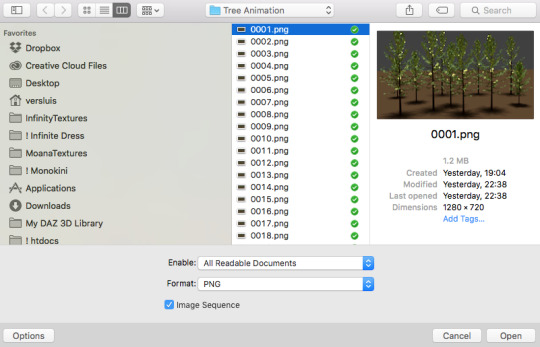
ATTENTION if you’re a Mac Sonoma user, MPV won’t be an option for you unless you downgrade your system. that is, if you have an Intel chip. if you have M1 Max chip (or even a better one), here’s a fix for MPV you can try while keeping that MacOS, because nowadays MPV is skipping frames in its latest build. or you can use MPlayer instead for less hassle. here are two tutorials for setting and using MPlayer. Windows users are fine, you can use MPV without trouble.
FOR EVEN MORE QUALITY
ADD NOISE
here’s a tutorial for adding noise as a way to achieve more HQ gifs if your original material is too low quality.
REDUCE NOISE WITH CAMERA RAW
instead of adding noise, you can reduce it, especially if your gif is very noisy as it is.
the path is filter > camera raw > detail > nose reduction. i do this before sharpening, but only my video file isn't great to begin with. because it’s a smart filter, you can reduce or increase its opacity by clicking the bars next to its name in the layers panel.
TOPAZ AI
i use Topaz Photo AI to increase the quality of my screencaps when i need to. it’s paid software, but there are… ways to find it for free, usually on t0rrent websites. if someone’s interested, i can make a tutorial solely about it in the future.
SHARPENING SETTINGS
here are my sharpening settings (filter > sharpen > smart sharpen). i sharpen things twice: 500% 0.4px + 10% 10px. here's an action for it, for more convenience. here's a tutorial on how to use Photoshop actions. for animated stuff, i use this action pack.

COLORING
here’s the gif i'm gonna use as a base. it’s already sharpened like the way i always do it.

LIGHTNING THE SHOTS
half of the secret of a good coloring is good lightning. i always useCurves (layers > new adjustment layer > curves) and Brightness & Contrast (layers > new adjustment layer > brightness & contrast). the settings depend on the scene you’re giffing, but i always try make my gifs bright and with high contrast to make the colors pop.
CURVES
besides lighting your scene, the Curves adjustment layer has four automatic options that will color-correct it for you. it’s not always perfect and it doesn’t mean you won’t need to do further coloring, but it’s a great start. it’s a lifesaver for most ridiculously yellow scenes. look at the difference! this gif uses the 3rd automatic option (the screenshot below isn't mine btw so that's why the fourth option is the chosen one), from top to bottom. what automatic option you need to choose depends on the gif.




sometimes i like to tweak my Curves layer. not everybody does that, it’s not that necessary and if you’re not careful, it can screw your gif up. to modify your layer by hand, you will need to click and drag points of that straight line in the position you desire. this is the concept behind it:

basically, the lower part of the line handles the shadows, while the upper part handles the highlights of the image. if you pull a highlight point up, the image’s highlights will be brighter. if you pull it down, it will make them darker. same thing for the shadow points. you should play with it to get a grasp of it, that’s what i did when i first started giffing.
BRIGHTNESS & CONTRAST
then i added a bit of brightness and contrast.

CHANNEL MIXER
the scene looked a bit too yellow, so i used the Channel Mixer (layer > new adjustment layer > channel mixer) adjustment layer. here’s a tutorial of how it works. not every scene needs the Channel Mixer layer though, i mostly use it to remove heavy overall tints. in this particular case, the Curves layer got rid of most of the yellow, but i wanted the gif to be just a bit more blue so the Channel Mixer tweaks are very minimal.

SELECTIVE COLOR
now, this adjustment layer i always use: Selective Color (layer > new adjustment layer > selective color). this is THE adjustment layer to me, alongside the Curves one. this is how it works:

ie, you can separately edit a color this way, giving it tints. for this gif, i wanted to make the colors more vibrant. to achieve that, i edited the selected colors this way:

for the reds, i added even more red in them by moving the first slider to the right, making the color more vibrant. for his hat to have a more warm tint, i added yellow to the reds (third slider, moving it to the right). finally, to make the reds stronger, i moved the last slider to the right (more black).
for the yellows, i made them brighter by adding white to them, thus making the tile wall and Paddington more bright as well.
for the cyans and the blues, i just added the maximum (+100) of black that i could.
i wanted for Paddington's nose to be brighter, so i added more white to the whites.
lastly, i added depth to the blacks by increasing their own blackness.
you should always play with the Selective Colors sliders for a bit, before deciding what you want or need. with time, you will automatically know what to change to correct the color grading. it all takes practice!
HUE/SATURATION
i don’t know if you noticed, but there are some green spots on the blue wall behind Paddington. to correct that, i added a Hue/Saturation adjustment layer (layer > new adjustment layer > hue/saturation) and made the saturation of the greens 0%, making that unwanted green disappear from the background.

while the green spots on the wall are specific for this gif, i use hue/saturation a lot to tweak, well, hue and saturation. sometimes someone’s skin is too yellow, i made it redder by tweaking the reds and the yellows, or vice-versa. the hue bar follows the rainbow bar, so the maximum settings (+100 and -100) give the selected color to change its hue to something more red or pink (the rainbow extremities). changing hue can give pretty whacky results, like turning someone’s skin tone to green, so you will need to play with it to get the hang of it. you can also tweak the opacity of your hue/saturation layer to further improve your gif’s coloring. i didn’t do it in this case, the opacity is still 100%. the reds and the blues had their saturation increased to make them pop just a bit more, without affecting the other colors.
COLOR BALANCE
the highlights of the gif still had a green tint to it due to the automatic correction of the Curves layer, so i used Color Balance. this is how it works: instead of giving specific colors some tints, you can give them to the shadows, highlights, and mid-tones. if your shadows are too blue, you counterbalance them with the opposite color, yellow. same thing with the cyan-red and magenta-green pairings. in my case, i added a bit of magenta.


B&W GRADIENT MAP
now, if this gif was a dish, it’s time for the salt and pepper. i always add a Gradient Map (layer > new adjustment layer > gradient map) (black to white gradient) with the Soft Light blending mode, thus giving my shadows more depth without messing with the mid-tones and highlights. it also doesn’t “deep fry” (you know those memes?) the gif too much by adding even more contrast. usually, the opacity of the layer is between 30% to 70%, it all depends on the gif. it always does wonders, though!

COLOR FILTER
finally, i like to add Color Filters (layer > new adjustment layer > color filter) to my gifs. it’s very handy when giving different scenes for the same minimalistic set because it makes them kind of match despite having completely different colors. in this gif’s case, i added a “deep blue” filter, opacity 50% density 25. you can change the density and the opacity of the layer for further editing, again, it all depends on the gif.



VIBRANCE
if i feel like it, i add a vibrance layer (layer > new adjustment layer > vibrance) to make the colors pop. this can ruin your coloring sometimes, especially when regarding skin color, so be careful. i didn't do it in this gif because i felt i didn't need it.
TA-DA! 🥳
AN OTHER EXAMPLE
the color grading of the original scene it’s pretty good as it is, to be honest. let’s see a worse scenario, a VERY yellow one:






no channel mixer this time because the automatic curves option dealt with the yellowness, but you can see it made the gif too green. i needed to correct that with the following adjustment layers:
curves (automatic option) (gif 2) >> same curves layer (tweaks) (gif 3) >> brightness & contrast (gif 4) >> hue/saturation (tweaked cyan+blue+green) >> selective color >> color balance (gif 5) >> b&w gradient map >> (sepia) filter >> vibrance (gif 6)
i added a hue/saturation layer to remove the blues & greens before my selective color layer because i thought that was more urgent than tweaking the tint of all colors. color balance (gif 4) was the real hero here, though, by removing the green tint. the selective color layer was meant to make the red pop more than anything else, because the rest looked pretty good, especially her skin tone (despite the green tint). you can notice that tweaking the curves layer (small gif 3) also helped A LOT with the green problem.
tl;dr 😵💫😵💫😵💫
here's a list of my go-to's while coloring and lightning gifs. it's not a rule, just a guide. there are gifs in which i don't use all these adjustment layers, or use them in a different order. it all depends!
1. curves (automatic option + tweaks) 2. brightness & contrast 3. channel mixer 4. selective color 5. hue/saturation 6. color balance 7. b&w gradient map 8. color filter 9. vibrance
i'll suggest that you study each adjustment layer listed for more info, either with other Tumblr tutorials or YouTube ones. the YouTube ones focus on images, but you can translate what they teach to gif making very easily. you can ask me to further explain any adjustment layer, too! i was brief to keep this short (which i kinda failed lol).
feel free to ask me for clarification or something else about gifmaking wise, i always like to help. ❤️
#*#*tutorials#gifmaker tag#resources#resource: tutorials#ps help#uservivaldi#tuserjen#userrin#userelio#useralien#userzaynab#userchibi#userbuckleys#usertj#userbess#tuserlucie#useraljoscha#userdavid#usershreyu#usernolan#userhallie#userisaiah#tusergio#tusergeo#userjesslynn
609 notes
·
View notes
Text
i think people should try a little Linux, just for something different yknow
doesn’t have to be any specific “beginner-friendly” distro or whatever, could just be WSL even . just gives you a different perspective on OSs :)
like if you’re sick of Windows/MacOS and are frustrated that you need to keep upgrading your hardware to run the newest versions, why not experience something else and download VirtualBox n try out a Linux distro for a bit, see if you like it,, I think you might be surprised by some of em :)
i still use Windows 10 for my desktop, mainly for gaming and art etc, but i switched over to Linux Mint on my laptop a while ago and have used it for school, and it’s been running better than when it had Windows on it. does what i need it to do, and using the terminal to do stuff feels fun and kinda powerful with how easy it is to install stuff with it :)
was there troubleshooting involved? yes, but it was often fixed by just looking up your problem and finding answers on stackexchange or linux forums, not too different from troubleshooting windows tbh lol
i’ve also recently got a mini pc to use as a little server for stuff, like discord bots. even tho the specs are a little on the lower side, it’s still able to run stuff pretty well since I installed Xubuntu on it, which is specifically designed to be quite light on system resources, and it’s been great too :)
anyways point is,, try out Linux in some form, why not :) if you have an old laptop/desktop sitting around, try reviving it by installing a lightweight linux distro on it! the less e-waste the better :3
104 notes
·
View notes
Text
huh. that's very silly
i was so shocked to learn that macbooks just. have a terminal emu with zsh. ig i'm so used to microsoft that i forgot everyone else standardized on *nix but part of me expected apple to have some kind of fucked up evil proprietary command line interface
#my hatred for macOS has slowly dwindled over the years#don't get me wrong#everything else that apple does is Evil#but if it weren't for lack of software support quod Fucking XCode/Metal I think OSX would be better than windows#however.#linux
21 notes
·
View notes
Text
Reasons to Get Your Hands on 4K Video Downloader
It has a free version. The free version lets you download 30 videos a day but that's better than nothing. And 30 videos a day actually goes a pretty gosh darn long way. Now if you were to exceed the 30 video limit mark then you can just use something like 9convert. I like it a lot.
It's cheap af to get a license. It's only $15 for 3 licenses if you'd rather have an unlimited number of downloads. You also get a reasonable discount when there's been an update and you'll even get a reasonable discount if or when you decide to upgrade!
You can download playlists. Need to download an entire playlist of video game playthroughs, trailers, music videos, tv shows, or whatever the case may be on YouTube?? Well, let's just say that 4K Video Downloader does this. I do it on the regular.
It's cross-platform. It works on Windows, macOS, and Linux. There's even an Android app for 4K Video Downloader.
It downloads from other sites besides YouTube. It legit straights up says on the website: Download videos from all popular websites including YouTube, Vimeo, TikTok, SoundCloud, Facebook, Twitch, Bilibili and more in high-quality.
The videos can download in hella high quality. If the video you're wanting to download has an option to watch it in 1080p then you can download it in 1080p. The same is equally true with the various other options to choose from.
#4k video downloader#not a tutorial#graphics#programs#f2u#youtube#facebook#vimeo#tiktok#soundcloud#twitch#bilibili
116 notes
·
View notes
Text
Zotoro, Scihub, and more Cool Hypnosis Papers
CW: severe nerdery
I don't have an academic background, and while I've been poking around at hypnosis nerdery for a while, I was limited to an extent by what I could get my hands on.
This is especially important when it comes to the academic texts. There's only so many books out there on theory, and a bunch of it doesn't make sense until you go back and read the actual papers.
For example, I knew that Kirsch had something to do with placebo and expectations, but I only had a vague understanding of what and how. A paragraph critique in Theories of Hypnosis wasn't enough to give me the proper context.
Until I decided I was going to rewrite the newbie guide to explain hypnosis from a modern neuroscience perspective and then I was committed to pulling the citations and digging up the actual papers.
At first I was doing it by hand by pasting things into Scihub and downloading the PDFs. This sort of worked, but at some point there are just too many PDFs and it's work to keep them consistent.
This is where Zotero comes in. It's a PDF database that is set up to scan for academic fields and give you a UI for finding, reading and annotating the PDFs. It syncs between MacOS, Windows, and iOS and keeps the annotations and highlights. And even better, it's got plugins.
Specifically, it's got a plugin for Scihub. You can add a DOI number and it'll pull the abstract data for the paper, and then you can right click and it'll download the paper from Scihub automatically.
It doesn't cover everything. Some stuff is too new for Scihub, and I've had to fallback to https://reddit.com/r/scholar to request articles, but there's so much stuff.
In particular, you get the sense of how academic papers can be a conversation, an argument, or a lawsuit. You get to see the most brutal putdowns phrased as passing comments. And the grudges and ego can go on for decades.
There are a couple of papers that I recommend everyone read, because they're just great at summarizing the field and current thinking.
The response set theory of hypnosis reconsidered: toward an integrative model
I love this paper not just because it goes over response expectancy theory from the inception to the general whittling down from "Once expectancy effects are eliminated, there may be nothing left" to response expectancy as 25%-35% of suggestibility and the addition of a "readiness response set" to cover the rest of it... but also because despite Kirsch's hand in response set theory and response expectancies and being in a journal issue devoted to Kirsch's career and achievements, he is not an author to this paper that is reconsidering his work. Instead, he gets a hand clap.
In closing, Irving Kirsch has greatly advanced our understanding of hypnosis. The construct of expectancies that he articulated and championed for decades has well withstood the test of time and replication. We extend our personal gratitude to him for his shaping influence on our personal views of hypnosis and for his many contributions to the field of hypnosis that he so immensely enriched.
I'm not sure what I'm looking at, but I love it.
How Hypnotic Suggestions Work – A Systematic Review of Prominent Theories of Hypnosis
This is a preprint, but it's comprehensive not just in how it picks out theories of hypnosis that are more recent than the book, but also in how it pokes holes and points out weak points in the various theories. It's also recent enough to talk about fun new things like predictive coding and interoception and somatosensory feedback.
Hypnosis and top-down regulation of consciousness
Devin Terhune's papers are always good to read. His papers read like a story where every chapter builds on the last one. This one is a "synthesis of current knowledge regarding the characteristics and neurocognitive mechanisms of hypnosis" and I can't tell you how many times I've read through this paper by accident because I wanted to pick a point out of it and got sucked into it all over again.
82 notes
·
View notes
Note
What is considered both a reasonable and maximum polycount for custom content hair and other types of custom content in The Sims 2 and does it depend on gaming specs? Also your work is great!
Thank you for taking the time to read it.
I, personally, use hair that is under 25K polys unless it's unique and cute. Anything over that is overboard and should get decimated. Any furniture or clothing over 10K is extreme for me.
As for specs, I'm inclined to believe that it's a game limitation, how powerful your computer specs are, and a secret third and fourth thing, your OS, and if you're a laptop user.
This OS talk is a side tangent, so bear with me:
Big disclaimer that this is all my opinion, not a factual piece. Don't take this as gospel and I'm far from an expert on operating softwares, computers, and CC for that matter. I went a little bit insane with the OS talk because you mentioned specs and this has been on my mind for a while 🥴
Every single time I've heard that someone installed TS2 on Linux, they are able to play on maximum settings with a BUNCH of CC for a long time and experience no pink soup or pink soup related crashing. I want to do my own research and play the same heavily detailed lot for the same amount of time on Windows and Linux and compare the differences as well as compare how they use resources differently. If I already did not have an attachment to Photoshop CC 2017, I would have made the switch by now.
Okay so Windows... I've played TS2 on my Asus laptop from 2020 and on my new desktop. Here's the spec difference
Laptop: Intel Core i7-9750H 6 Core Processor, 8 GB RAM, NVIDIA GeForce GTX 1650 (Windows 10)
Desktop: AMD Ryzen 5 2600X Six-Core Processor, 16 GB RAM, NVIDIA GeForce GTX 1080 Ti (Windows 11)
My laptop was really good for it's time (I bought it in March 2020), but it was pink soup galore for any cluttered CC lot, even with all of the fixes and GRM edits. My current setup is a mish mosh of my bf's and ex's computer parts and it runs perfectly fine, but I do not play long enough to encounter pink soup. (I have a job and I mainly play to get CC previews these days.) If you noticed, both my CPU and GPU were made before my laptop was sold, and yet it still performs way better. Laptops with top of the line hardware will never be more powerful than PCs with even mid to high level hardware from 5 years ago. Don't forget that laptops will throttle performance to protect itself from overheating and causing damage.
There is also no difference between installing and playing the game on Windows 10 and Windows 11, except that you should absolutely uninstall OneDrive if you haven't already. There might be some issue if you install with discs, but I don't own the discs.
And as for Mac, I truly believe that Mac is the worst way to experience Sims 2. Between the Super Collection crap, not being able to use third party tools (SimPE, Hair Binner, any other .exe files made to run for Windows), and the file limit that really hits you hard if you download a bunch of CC that you can't merge anyway because CCMerger can't run on Mac. I should say I have never played Sims 2 on a Mac, but this is my opinion after reading about the struggles of other MacOS users online.
The point of this OS tangent? None, really. I'm not trying to persuade you to use Linux or stop using Mac, this is simply what I've noticed and my opinions on the matter. There's millions of variables I did not cover such as DXVK, texture sizes, difference in specs between each OS and user and many other things I am forgetting.
Feel free to correct, add on, extrapolate or whatever. If you have any thoughts, please comment, add it in reblogs, or tag me in your post. I'm very interested in the current topics about high polys, pink soup and big textures for this game.
#spell.txt#cc discussions#my opinion on macs wont change though#sorry mac users#only thing im qualified for in this discussion is my photoshop certificate lmao
17 notes
·
View notes
Note
Hello there! I hope you don’t mind me just dropping into your asks like this, but by all means def feel free to just delete this if so, it is kind of a weird ask.
This is the anon from the computer blog asking about a private laptop for collage! After doing (a small amount of) research into Linux, one thing that’s super confusing to me, is… how does one know which distro to use? You mentioned in the replies of the post that you use Ubuntu Linux, which seems to be one of the more popular ones. Would you recommend — and if so, why? Is it good for privacy, do you think? The best? Does the user need to have a good deal of experience with computers to keep it running? (I’ve never used a laptop before but I don’t mind trying to learn stuff)
Also this is an EXTREMELY stupid question my apologies, but how….. exactly do you put Linux on a laptop? OP from my ask said to buy a laptop with no OS but is that something you can do? I’d think so, since 0P works with computer and stuff as their job, but Reddit says that it’s not really possible and that you should just “buy like a Windows laptop and scrap the software”??? Is that… correct? How did you install Linux on your laptop — did y ou have to remove software off it or did you, as OP says, manage to find a laptop with no OS?
Again, feel free to ignore if you don’t wanna put in the time/effort to reply to this, I absolutely don’t mind — it’s a lot of stuff I’m asking and you didn’t invite it all, so ofc feel free to delete the ask if you’d like!
ha, you've zeroed in on one of the big reasons Linux is kind of a contrarian choice for me to recommend: the wild proliferation of distros, many of them hideously complex to work with. luckily, the fact that most of them are niche offshoots created by and for overly-technical nerds makes the choice easier: you don't want those. you want one of the largest, best-supported, most popular ones, with a reputation for being beginner-friendly. the two biggies are Ubuntu and Linux Mint; i'd recommend focusing your research there.
this isn't JUST a popularity-contest thing: the more people use it, the more likely you are to find answers if you're having trouble or plugging a weird error message into google, and the greater the variety of software you'll find packaged for easy install in that distro. some combination of professional and broad-based community support means you'll find better documentation and tutorials, glitches will be rarer and get fixed faster, and the OS is less likely to be finicky about what hardware it'll play nice with. the newbie-friendly ones are designed to be a breeze to install and to not require technical fiddling to run them for everyday tasks like web browsing, document editing, media viewing, file management, and such.
info on installation, privacy, personal endorsement, etc under the cut. tl;dr: most computers can make you a magic Linux-installing USB stick, most Linuces are blessedly not part of the problem on privacy, Ubuntu i can firsthand recommend but Mint is probably also good.
almost all Linux distros can be assumed to be better for privacy than Windows or MacOS, because they are working from a baseline of Not Being One Of The Things Spying On You; some are managed by corporations (Ubuntu is one of them), but even those corporations have to cater to a notoriously cantankerous userbase, so most phoning-home with usage data tends to be easy to turn off and sponsored bullshit kept minimally intrusive. the one big exception i know of is Google's bastard stepchild ChromeOS, which you really don't want to be using, for a wide variety of reasons. do NOT let someone talk you into installing fucking Qubes or something on claims that it's the "most private" or "most secure" OS; that's total user-unfriendly overkill unless you have like a nation-state spy agency or something targeting you, specifically.
how to install Linux is also not a dumb question! back in the day, if you wanted to, say, upgrade a desktop computer from Windows 95 to Windows 98, you'd receive a physical CD-ROM disc whose contents were formatted to tell the computer "hey, i'm not a music CD or a random pile of backup data or a piece of software for the OS to run, i want you to run me as the OS next time you boot up," and then that startup version would walk you through the install.
nowadays almost anyone with a computer can create a USB stick that'll do the same thing: you download an Ubuntu installer and a program that can perform that kind of formatting, plug in the USB stick, tell the program to put the installer on it and make it bootable, and then once it's done, plug the USB stick into the computer you want to Linuxify and turn it on.
Ubuntu has an excellent tutorial for every step of the install process, and an option to do a temporary test install so you can poke around and see how you like it without pulling the trigger irreversibly: https://ubuntu.com/tutorials/install-ubuntu-desktop
having a way to create a bootable USB stick is one reason to just get a Windows computer and then let the Linux installer nuke everything (which i think is the most common workflow), but in a pinch you can also create the USB on a borrowed/shared computer and uninstall the formatter program when you're done. i don't have strong opinions on what kind of laptop to get, except "if you do go for Linux, be sure to research in advance whether the distro is known to play nice with your hardware." i'm partial to ThinkPads but that's just, like, my opinion, man. lots of distros' installers also make it dead simple to create a dual-boot setup where you can pick between Windows and Linux at every startup, which is useful if you know you might have to use Windows-only software for school or something. keep in mind, though, that this creates two little fiefdoms whose files and hard-disk space aren't shared at all, and it is not a beginner-friendly task to go in later and change how much storage each OS has access to.
i've been using the distro i'm most familiar with as my go-to example throughout, but i don't really have a strong opinion on Ubuntu vs Mint, simply because i haven't played around with Mint enough to form one. Ubuntu i'll happily recommend as a beginner-friendly version of Linux that's reasonably private by default. (i think there's like one install step where Canonical offers paid options, telemetry, connecting online accounts, etc, and then respects your "fuck off" and doesn't bug you about it again.) by reputation, Mint has a friendlier UI, especially for people who are used to Windows, and its built-in app library/"store" is slicker but offers a slightly more limited ecosystem of point-and-click installs.
(unlike Apple and Google, there are zero standard Linux distros that give a shit if you manually install software from outside the app store, it's just a notoriously finicky process that could take two clicks or could have you tearing your hair out at 3am. worth trying if the need arises, but not worth stressing over if you can't get it to work.)
basic software starter-pack recommendations for any laptop (all available on Windows and Mac too): Firefox with the uBlock Origin and container tab add-ons, VLC media player, LibreOffice for document editing. the closest thing to a dealbreaking pain in the ass about Linux these days (imo) is that all the image and video editing software i know of is kinda janky in some way, so if that's non-negotiable you may have to dual-boot... GIMP is the godawfully-clunky-but-powerful Photoshop knockoff, and i've heard decent things about Pinta as a mid-weight image editor roughly equivalent to Paint.net for Windows.
50 notes
·
View notes
Text
Ooo my brain requires multitasking during this talk so I'm gonna be spicy and start some Disk Horse with a Warmed Take that won't piss everyone off, but will mildly annoy everyone
I'm like 99% sure that the only reason why people view all linux distros as this esoteric black box of a godlike operating system for powerusers is because linux users advising them how to use it have WAY higher standards than necessary for what "baseline functionality" is.
Ubuntu literally has more functionality and is more user friendly than either macOS or windows without any modification or complicated installs and applications. A huge part of this is straight up because of the open source environment, which means less boundaries to installing whatever software you want without worrying about constant internet access, license codes, centralized accounts, etc etc etc. And that benefit is immediately apparent! Setting up windows is a multihour affair. MacOS works straight out of the box, but will hit you with a brick wall of accessibility every once in a while. Introductory linux packages have none of that, and that's all most people want- free, easy to use office applications, smooth web browsing, and the freedom to install the software they want for their own needs (which has gotten way better for linux recently, esp with things like Proton). A basic Ubuntu or Mint install will provide all of that.
If your explanation to someone about why they shouldn't use ubuntu when they're fresh off windows and trying to find an alternative involves a breakdown of snap vs apt and the backend functionality of how packages are maintained for each one, you're part of the problem LOL
And if your reaction to that is "well they SHOULD care" they're already caring far more than the average person by switching to linux.
89 notes
·
View notes
Text
Why the year of Linux isn't actually happening
This is a long post so make sure that you have some time to actually read it.
I'm going to say some things that linux users may hate, but it is the fucking truth.
we all hope for the year of the linux desktop, but the thing is it will never happen until it gets more user friendly. Yes you heard it right, it has to be USER FRIENDLY.
This is the reason that ubuntu, mint, elementary, etc. are so popular. Because mint is good if you're transitioning from windows, elementary OS is good for if you're transitioning from MacOS. And Ubuntu is User-friendly and has a high amount of support. It doesn't have a familiar UI, but the learning curve is relatively easy. Plus if you're me, you have actually riced Ubuntu and made it look 100% different from what ubuntu looks like
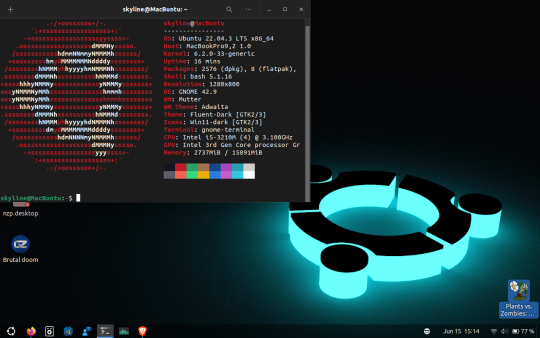
This was my Ubuntu rice, it is completely derailed from the original look which is this:
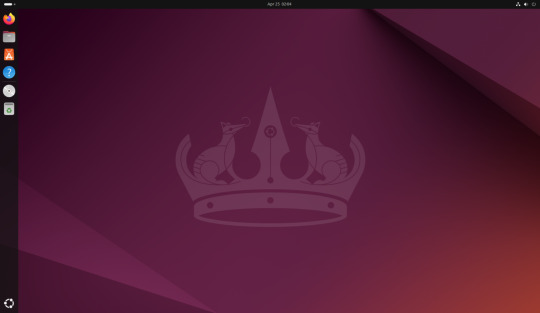
this is Ubuntu 24.04 LTS "Noble Numbat"
Now yes there are some shitty things Ubuntu has done, like sell user data to amazon. However that was in the past and my views are if someone (or in this case a company) has actually changed their ways, they deserve a second chance. Ubuntu has telemetry yes, but if you actually look at the source code for the telemetry (they let you do that at the installer) you will actually notice there is no user data reported. They only report the specs of your PC to Ubuntu, and the reason for this is to help better Ubuntu and expand support. Ubuntu is actually making an effort to make the year of the linux desktop actually happen.
Now yes people may have their opinions on Ubuntu and their implementation of GNOME, but really in this version of Ubuntu, canonical has fixed the issues they had. See the Buggy GNOME desktop environment was from this weird move they did in the name of stability. They would roll back the version of GNOME so you were 6 months behind. Yet use the latest extensions for GNOME, thus causing some frankenstein, GNOME thing. This is why GNOME is so buggy. the thing is Ubuntu did this for stability when even Debian didn't do this. If Debian, the mother of linux distros didn't do this weird frankenstein GNOME, then why did Ubuntu need to. But Canonical changed this and is now on the right track with Ubuntu 24.04. Now the other thing is the forcing of snaps down people's throats, this is a very shitty thing to do. To be honest with you, I would actually try snaps out if Ubuntu did NOT do this move that they do.
This is the same thing with some distros only allowing open source software, otherwise they just crash (yes there are some out there). Yes FOSS (Free and Open Source Software for the people who don't use linux, or use linux but don't know the term yet) is really great, but that doesn't mean become Ubuntu with their snaps and force FOSS down their throats. It is really nice when you have freedom, when you have the choice to not use FOSS and use Proprietary Software. Because now you have made the choice instead of had a gun pointed to your head and FOSS was the only thing you could choose to use otherwise the trigger would be pulled.
Now these distros are the minority and you don't really have to worry about that. But the thing is Ubuntu, I would actually take a bite out of the snap package cake, if you weren't shoving it in my face. I have actually heard of a new feature that canonical has released for snaps that fixes these slow boot times. And I have heard that some snaps actually run faster than flatpaks. such as some video editors. But these instances are most likely few and far between. Canonical making snaps is similar to another project that they did a long time ago. and that was create unity. They suffer from Not Invented here syndrome. Now Unity was actually a great move that they did when you consider why they did it. GNOME 3 just released and it changed the entire desktop environment and made it completely different. And Ubuntu didn't want to go with this new change. Because they didn't want their users to have to adapt to an entirely different workflow. So canonical made unity instead. Now eventually Unity failed and so they decided to instead, modify GNOME. But if you look at what they did when they made this move. Unity influenced what Ubuntu is today. Look at unity, and then look at Ubuntu 24.04. you can see what they took from their loss and made into a success.
Now if you made it this far, congratulations here is a cookie for you! 🍪. But now we're going to start talking about things other than user-friendliness. And that is what people use computers for. See the average Joe uses a computer for browsing the web and doing maybe a few word documents and that's about it. But if you're anything like me. You one, have differing opinions that highly oppose even the 1% (literally this entire tumblr post), but you also want to use a computer to go into a world where you rip and tear demons to shreds deep in the depths of hell, or you want to use a computer for killing greek gods. Or use a computer to open a portal to an alien world and destroy society. If you can't pick up on the references, what I'm saying is you use computers for a niche such as gaming. gaming is widely known, but the most common platform for gaming is the phone. not the console or the PC, the phone. Linux PCs are used more for getting work done. Hell, my dad who works at lenovo, installed ubuntu onto a mid 2012 macbook (btw that is the best laptop I have owned so far, it is so fast it scares me, how tf is a 2012 laptop that fast), he also has a hard drive with ventoy installed on it to boot other live environments so that he can work on his other projects (which he has a blog and he is working on a home lab setup).
funny thing is he doesn't specify on his blog what he uses ubuntu on, he just says he has a machine that uses it. So yeah he uses a Macbook Pro 9,2 (Mid 2012 13 inch), same as me
But the thing is, Yes linux gaming has come a long way. It really has, but the thing is that it's still not there yet. If you watch SomeOrdinaryGamers/Mutahar you would know that he plays games on Arch Linux (BTW) but he still has to fire up Windows in a Virtual Machine to play some of the games he has just because they do not work on Linux. If you want linux to take the market share. If you want this year of the linux desktop, you need to have games and such actually run on linux.
Now like I said linux is great for the average joe. If you gave the average Joe three laptops with a browser open and told him to just surf the web for a little bit, he would not be able to tell the difference between the OSes other than the UI being a little different (taskbar position, taskbar design, Icons, you know things like that).
The only people who would know what OS you just gave them are the people who engage in these niches such as cybersecurity, Development and Gaming (there are other niches I haven't covered, but let's keep it simple). Linux has two of the three listed here 100% covered. it's the third one that is the problem. The thing is let's use roblox as an example just because why not. They never actually made their game for linux. they just enabled wine support and told their linux playerbase to use wine (recently they disabled this wine support because people were using vinegar, a popular wine wrapper used to run roblox, to cheat in the game).
Now the Proton project has done an AMAZING job at this. In fact the steam deck had our hopes high for the year of the linux desktop. And honestly, I think we're close to if not on the home stretch here.
Alright so we understand the user friendliness and the gaming piece of the puzzle, but let me elaborate more on the user friendly.
I have recently seen this video where people asked Linus Torvalds some questions on why he doesn't use Debian or Ubuntu and he said something here that really resonated with me. he said that he wants a distro that is easy to install because he has a life. And this is the thing. look at MacOS, look at Windows, fuck look at ChromeOS for that matter and look at their installation experience. You see how user friendly it is.
Now look at installing apps, Windows you install a .exe file, hope and pray that it's not a virus, run it and you're done. you can also use a .msi file to install your app if you want to. MacOS, you download a .dmg file and copy it to your applications directory, simple as that. Hell it even gives you a fucking window that tells you "drag to install" and you drag the program into the applications directory.
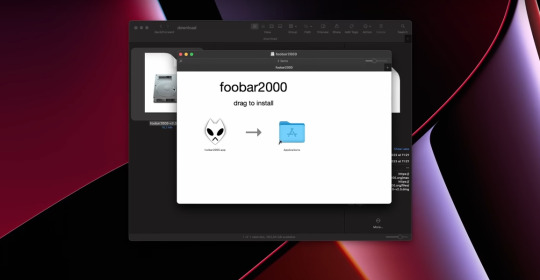
this is from Livakivi's MacOS challenge video down below
youtube
Now this video shows me one: reasons why I shouldn't use MacOS, and two: user friendliness features that if put in Linux, it can cause the year of the Linux desktop we've all been waiting for.
Now installing stuff on linux, you have to type in one command. But for some people, that terminal is a scary place that they don't want to be. And so there is the way of installing it using a .deb file or a .rpm file. But the thing is that way is the wrong way. That is how you get malware, yes even though linux doesn't have much malware, it still has some. Hell, when I used Ubuntu (I use Kubuntu now) the Ubuntu software thing would actually WARN ME, that .deb packages had the capability of installing malware. But another point to make is that, deb and rpm files are only available for Debian and it's billions of forks, and fedora (and possibly it's forks, idk if it has any though).
Now there is a solution to this problem though, and that is the Discover app, (or the GNOME software app). these apps basically use the terminal method of installing the apps, making it more secure because they install packages that are checked for malware. But they just make it easier for your average joe to install them. They make it so easy that even your grandmother can do it. But the issue doesn't appear when you look at how not every desktop environment has the software app, meaning not every distro has the app because you can just use a distro that has the app. But the issue arises with the fact that some apps require you to add the repository in order to install it. There has to be some way for the software app to look at all repositories without adding them until you install a piece of software from it. Sort of like how a browser skims through the websites or something like that.
Yes there is documentation on how to do this type of stuff, but the thing is. With Windows, it just does it. Now I'm not saying linux should be like windows or Mac OS hell nah. What I'm saying is linux should be as noob friendly as windows and Mac OS.
The conclusion to this entire thing is that the year of the Linux desktop will never happen until the noob distros become as noob friendly as Windows and MacOS. Where you don't need a manual to use it. All you do is click a button and "oh that's what it does". It needs to be able to be used by someone who doesn't know shit about computers, and has never touched a command prompt in their life. Yes you might say "BuT tHe CoMmAnD pRoMpT iS tHe EnTiRe PoInT oF LiNuX!!!11!11" yes, but the thing is there has to be a distro for the ones who don't want to touch the command prompt
12 notes
·
View notes
Note
Hey so what's Linux and what's it do
It’s an operating system like macOS or Windows. It runs on like 90% of servers but very few people use it on desktop. I do because I’m extra like that I guess.
It’s better than Windows in some ways since it doesn’t have a bunch of ads and shit baked into it. Plus it’s free (both in the sense of not paying and the sense of freedom [like all the code is public so you know what’s running on your system, can change whatever you want if you have the skills to, etc]). Also it’s more customizable.
The downside is a lot of apps don’t run on it (games that have really invasive anti-cheat [cough Valorent cough], Adobe products, Microsoft office — although a shit ton of Windows-only games do run totally fine). There’s some alternatives, like libreoffice instead of MS office (also anything in a browser runs fine, so Google docs too). GIMP as a photoshop replacement does exist, it’s fine for basic stuff but I’ve heard it’s not great for advanced stuff.
#also linux users are like vegans in that if they are one they’ll tell you they are#and also tell you why you should be#oh also android and chromeos are both based on linux#linux#sorry this post ended up so long lol
55 notes
·
View notes
Text
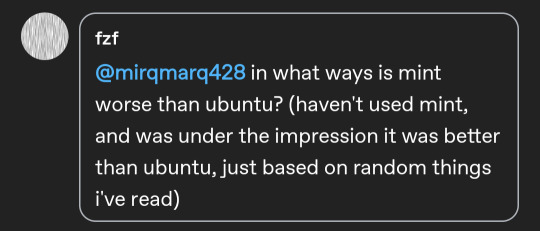
Replying to @fzf
I have no strong personal feelings about mint. It happened to be a good first distro for me, and i like the colors. My disrecommendation of it comes in bullet points:
Mint is touted as a "windows-like environment" on account of the Cinnamon desktop. However, Cinnamon and windows 10 have deceptively little in common beyond the general layout - iv said this before and I'll say it again: don't give people a knockoff of what they're used to, give them something new to learn.
Mint disables, disallows, discourages, and distrusts snap packages. While iv seen a huge amount of hate for these, and the technology had a rough start, they're not any more of a pain than flatpak (and way better than appimages, yikes). In fact, removing them from what was otherwise an Ubuntu system causes more problems than it fixes - for months last year it was a pain to run Chromium on mint because the Deb was broken and snaps were disabled (iirc - might be misremembering. either way the snap war is not a good cause imo)
Release speed - when i got started with Mint in march of 2020, I downloaded mint 19.04 cause that was the version on the website. Mint 19.04 is based on Ubuntu 18.04 which had a 4.18 kernel. Everyone else in 2020 had a 5.2 kernel at least. There is a balance between stable and up-to-date, and Ubuntu has mastered it. Mint, by necessity, lags behind Ubuntu. Heck, there's even the time the mint devs had to beg users to update because of a security issue, and found that most users had never bothered updating!
Ubuntu (gnome) is different from both macos but windows interface in obvious ways that encourage a paradigm shift in desktop usage.
Snap packages are extremely meh, but they ain't here to steal ur freedums (yet).
Ubuntu has the second best software compatibility of any Linux (best is Arch), and a lot of pkgbuilds in the AUR are just extracting debs from Ubuntu ppas anyway so it's really close. Ubuntu tells you to update and makes it easy with the popup which you can close or banish.
So yeah. Mint is just slightly worse Ubuntu
23 notes
·
View notes
Note
Your graphical character entry menu looks a lot like the one I get in Linux Mint when I hit Control+Semicolon, but mine only works on certain GTK applications, excluding Emacs & Firefox, and it only searches for emojis. What's your setup?
(context: bragging about text input)
That's macOS's emoji menu, which also supports other characters. You bring it up with Ctrl+Cmd+Space, that's the default shortcut that should work on any Mac (it also works on iPhone/iPad with an attached keyboard, but that one only has emoji).
I would say that one of the biggest reasons I use macOS is its text input; it's much better out-of-the-box than anything I've managed to manually configure in Windows or Linux.
Out of the box, you can type accented characters. The modern way is that you hold down the letter and it lets you choose an accented version. For instance, this is from holding down e:

I usually turn that off, though, so I can use key repeat. I use the old way, dead keys: Opt+E will add an acute accent to the next letter you press, so Opt+E A will produce á.
Windows, on the other hand, will simply be "nope" out of the box, I guess you can memorize altcodes, or you could use their US International keyboard layout. But their US International keyboard layout replaces the apostrophe button with the acute accent button! I want to be able to type in other languages without making it harder to type English!
Meanwhile, out of the box on macOS I can talk about how it's 35°C outside, and I had crème brûlée last night, and I have like ≥50¢ in change that I'm trying to Get Rid Of™. And that's just English!
Out-of-the-box, in addition to English, it's also pretty easy to type Spanish and French and a bunch of other common European languages, but I actually use the ABC Extended keyboard because I want to type more obscure words from Pinyin (lǘ) and Esperanto (ĝi). And I can do it all on one keyboard! I don't need to switch input languages or anything!
My input menu only has three keyboards:

And it's enough to cover the nineish languages I type in (I wouldn't say I'm good at any of these languages, I'm just a linguistics nerd).
For Chinese and Japanese, it comes with kanji handwriting recognition that just has you draw on the trackpad, which has come in handy SO often:

And these are all features it had over ten years ago!
23 notes
·
View notes
Text
Spacetop G1, World’s first Laptop that uses AR Glasses instead of a Display
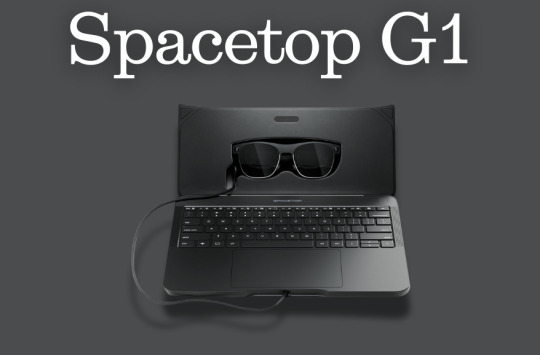
A laptop that employs augmented reality glasses as a display was called the Spacetop G1 system, and it was shown to a thousand productivity pioneers by the tech firm Sightful last year.
The upgraded Gen 1 device removes the requirement for the user to stoop over a tiny screen when working remotely on a laptop by placing a 100-inch virtual display directly in their eyes.
In this blog, The TechRobot will showcase the World’s first AR laptop: Spacetop G1. So let us begin.
What is Spacetop G1?
Sightful’s Screenless Laptop, the Spacetop G1, combines a computer with comfortable, lightweight augmented reality glasses. Running on the device is SpaceOS, a spatial operating system with an emphasis on online operations intended for productivity.
The weight of the AR glasses is 85 grams, but the Vision Pro, depending on the Light Seal, weighs between 600 and 650 grams. The keyboard is bulkier compared to a MacBook Air or iPad Pro, measuring less than 12 inches in width and weighing three pounds.
Cost of AR Laptop
The Screenless Laptop, Spacetop G1 charges $1,700 and is just a keyboard with spectacles attached.
Spacetop G1 Specs
Spacetop G1, features a Qualcomm Snapdragon QCS8550 CPU, Kryo GPU, Adreno 740 AI, dual eNPU V3, 48 INT8, 12 FP16 TOPs, 16 GB LPDDR5, 128 GB UFS3.1 storage, and 8-hour battery life.
They have two OLED display screens, a 50° field of vision, a 90Hz refresh rate, and very crisp text rendering.
The glasses enable Wi-Fi, Bluetooth, 5G, and a 5MP camera. They also contain a microphone for use in online meetings.
Benefits of AR Laptops
1. Endless View
With Spacetop’s Virtual Desktop, you may get amusement and information without having to navigate around, making it a convenient substitute for real screen space. Although it’s not the only solution with this functionality, this one could be the easiest to use.
A standard keyboard and touchpad, Spacetop’s AR glasses, and a perhaps lower price tag might allow customers to enjoy endless screen areas without sacrificing functionality. For individuals who would rather have a more ordered workstation, this would be a time-saving alternative.
2. Absolute privacy
Multi-monitor laptop attachments should not be used in public areas due to the increased danger of uninvited eyes peeping at private information caused by an excessive number of physical displays. Although privacy screens are available on certain computers and monitors, they are limited to one monitor.
To solve this, Spacetop is a Screenless Laptop, letting the user see their screen alone until it is shared with others. But it also means that those standing close to the user can’t see the screen without their glasses.
3. Improved posture
Laptops’ screens are firmly attached to the keyboard, making them portable yet uncomfortable. Some people find relief from this neck pain by attaching a desktop monitor.
The screenless laptop, Spacetop, provides a more comfortable height and does away with the need for arms or ergonomic monitor supports. Due to this, laptops are a better choice for use at home or in the workplace.
4. Laser Focus
Spacetop G1 is an Augmented Reality (AR) device that reduces visual distractions so users can work productively and enjoy their free time. The apps it may utilize, including Windows or macOS-based software and limited gaming, are restricted by its Android-based operating system and mobile hardware.
Notwithstanding these drawbacks, Spacetop provides a more practical experience than a typical computer since it places all of the necessary components in front of and surrounding users. Instead of letting others decide for them, users may choose whether to allow virtual distractions to affect them.
Highlight – Introducing Travel Mode For Meta Quest Headsets
Best AR Glasses for Laptops
1. Apple AR Glasses
Apple plans to develop AR glasses that look like conventional spectacles with a built-in display. A prototype of the glasses has a thick, attractive frame and resembles high-end luxury sunglasses. With references to Project Starboard and reports of a glassOS, the prototype is anticipated to function on iOS 14.
Though it could take a few more years for a public release, rumors indicate that Apple has already started the second phase of development. The glasses will have the ability to add prescription lenses, gesture-controlled instructions that connect with the Apple Watch, and a true vision display on both lenses.
Possible capabilities include the ability to use virtual things in real-world settings, do activities without using a phone, and enable immersive phone conversations and remote collaboration software.
2. Meta Glasses
Rebranding Facebook to Meta, Mark Zuckerberg is concentrating on augmented reality glasses and headsets. The business plans to deliver Meta spectacles, a prototype of their augmented reality spectacles, in late 2024. The Project Nazare and Project Aria prototypes provide a fully functional augmented reality experience, with 3D visuals and an elegant design. It is anticipated that the Meta Glasses will include an immersive experience with radio, speakers, and cameras, a holographic display with built-in projectors, batteries, and sensors, and a broad field of vision. In 2024, the prototype is anticipated to be released.
3. Xreal Air 2 Ultra
The Air 2 Ultra glasses from Xreal are an improvement over the Air 2 model and are aimed at competing with Apple’s Vision Pro and Meta’s Quest 3 headsets. Complete positional tracking, a form factor akin to eyeglasses, and compatibility for immersive AR apps, TV viewing, and flat-screen gaming are all features of the Air 2 Ultra.
It has a 52-degree field of vision, 500 nits of brightness, two cameras for environmental mapping, hand tracking, and compatibility with Xreal’s Nebula AR environment.
Is AR safe for your eyes?
Prolonged use of AR might result in headaches, nausea, and straining of the eyes. This is a result of our eyes continually focusing on objects at different distances when using AR. This can cause pain and eye tiredness.
Conclusion
The future of laptops with AR like the Spacetop G1 marks a breakthrough in laptop technology by utilizing augmented reality to provide a 100-inch virtual display that improves user posture, productivity, and privacy.
The Spacetop G1 presents a new option for remote work by addressing typical ergonomic concerns associated with standard laptops by mixing AR glasses with a powerful computing machine and the SpaceOS operating system.
Despite several drawbacks associated with its Android-based operating system and the possibility of eye discomfort after extended usage, the Spacetop G1 breaks new ground in augmented reality technology by offering consumers a more useful and engaging experience.
#spacetop1#ar#vr#ar glasses#laptop#virtual reality#augmented reality#mark zuckerberg#elon musk#meta ai#facebook
6 notes
·
View notes